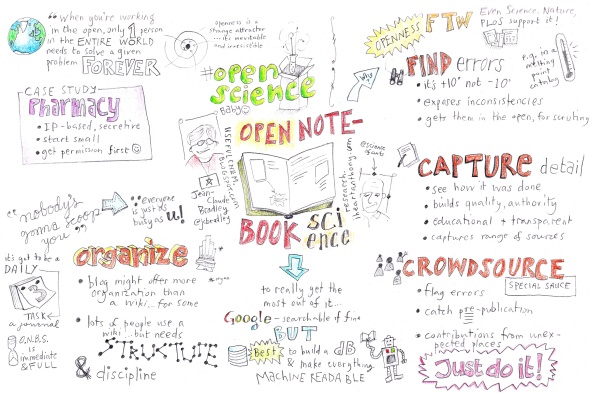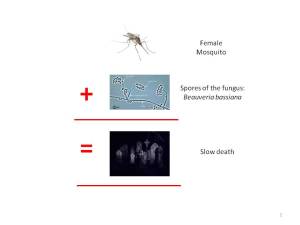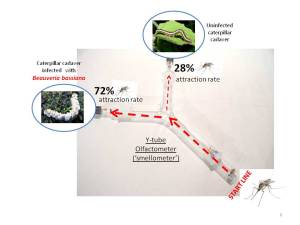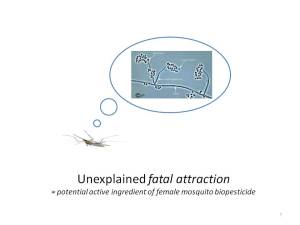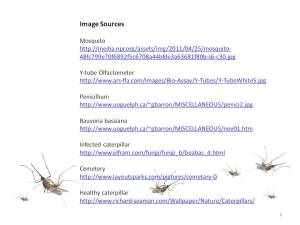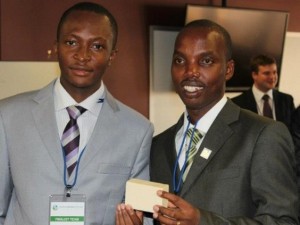A Fatal Attraction to Fungi in 8 Graphics
Posted: July 18, 2013 Filed under: Disease, Research, Uncategorized | Tags: active ingredient, Beauveria bassiana, bio-pesticides, biopesticide, death, fatal attraction, fungi, fungus, hygiene, infectious disease, insecticide, Malaria, malarial research, mosquitoes, pesticide, preventative measures, Research, resistance, vaccination, y-tube olfactometer Leave a commentAs a Thursday night post I’ve decided to share my mini class presentation with you. How lucky are you?! (But ‘lady luck’ could be a whole other blog post topic…)’
As part of the assessment for our ‘Communicating with Science’ course we were required to mentally digest and communicate the contents of a peer-reviewed scientific journal article in a 2 minute timeslot followed by a brief Q & A with our classmates and a couple of obliging ring-ins. It was a very useful and practical exercise pin-pointing what the most significant and interesting aspects of the paper were with a view to being able to then communicate the information clearly and accurately… and of course, engagingly. With another assignment due the previous night preparation time was limited…
I opted for a 2013 paper I had already read for my blog post, ‘Why might stinky feet be so important in the fight against malaria?’ but had only briefly referenced. This is a tale of fatal attraction and I hoped its quirkiness might appeal to the audience comprised of my classmates (and assessors) as it had to me.
The Paper…
The paper detailed experiments focussing upon fungus as an active ingredient in a biopesticide control of malaria mosquitoes. I love it when the natural world has the answers, and especially when those solutions can trump our own ‘inventions’ and their associated adverse side effects. And so the concept of biopesticides (with a likelihood of less harmful side effects) seems really cool to me.
The Presentation…
Slide 1.
Malaria is a mosquito-borne infectious disease. It begins with a bite from an infected female mosquito, which introduces the microorganisms through saliva into the circulatory system from where they travel to the liver to mature and reproduce.
A mounting problem with preventative measures for controlling malaria is that mosquitoes are becoming resistant to some chemical insecticides and so some researchers are looking at alternative biopesticides (‘a form of pesticide based on micro-organisms or natural products’).
(Click on slide for enlarged image)
Slide 2.
In this case the active ingredient under research is a fungus called Beauveria bassiana which infects insects and kills them slowly (in relative terms for insects… 1-2 weeks for mosquitoes).
(Click on slide for enlarged image)
Slide 3.
Previous research has shown insects may be deterred from landing upon pesticides which are harmful to them. If the fungus proved a deterrant to its target than it would not be an effective active ingredient in a biopesticide. Hence, the researchers wanted to see if mosquitoes would be repelled by the Beauveria bassiana. They did this by giving a ‘cage’ of mosquitoes a choice between two fungi using a y-tube olfactometer (I like to call it a ‘smellometer’). And to the researchers’ collective delight, the mosquitoes chose Beauvaria (despite its fatal effects) over the less harmful and obviously less sweeter smelling Penicillium. This suggested the Beauveria bassiana smells almost irresistible to female mosquitoes. That would seem to suggest the researchers had been successful in reaching the objective of their experiments… but they wanted to go further. They knew mosquitoes would almost definitely become infected by landing upon a surface to which dry fungi spores had been applied (tests showed a 95% likelihood) but this would likely prove a very onerous, time intensive and expensive task – especially when considering the extent of land where malaria is present. And so the researchers also looked to prove that Beauveria bassiana is irresistible to female mosquitoes through ‘natural’ transfer.
(Click on slide for enlarged image)
Slide 4.
In this case, the fungus takes advantage of the mosquitoes somewhat gruesome predilection for feeding upon insect larvae, dead or alive. And mosquitoes are particularly partial to the squishy, tender bodies of caterpillars…
(Click on slide for enlarged image)
Slide 5.
… which may already be infected by Beauveria bassiana and dying a slow death. The researchers tested a hypothesis that female mosquitoes would be drawn to infected caterpillars over infection free caterpillars. (Click on slide for enlarged image)
Slide 6.
The earlier test was repeated but with cadavers of caterpillars infected with Beauvaria bassiana against caterpillar cadavers which weren’t infected. Similar results were achieved.
(Click on slide for enlarged image)
Slide 7.
While this proves that Beauveria bassiana could be a very useful active ingredient in bio-pesticides to prevent malaria, the researchers couldn’t fully explain the fatal attraction the fungus had for the female mosquitoes. These are also experiments at the early stage of developing a biopesticide. Conclusion: More research needs to be undertaken.
(Click on slide for enlarged image)
Slide 8.
Interestingly, research has also shown, the slow death by biopesticides (in comparison to the rapid death caused by insecticides) also makes it harder for the mosquito population to build up a resistance. Isn’t that cool considering the ability of mosquitoes to build up resistance to traditional pesticides has been affecting the ability to control mosquito populations recently? Win-win, I say.
(Click on slide for enlarged image)
In case, you’re wondering – Yes it did run over the allocated two minutes…. do you know how fast two minute speeds by? Feedback suggested I could have left out slides 4, 5 & 6 and just covered the key investigation of the experiment.
Interesting questions I fielded from the audience included among others: whether application costs of biopesticides were affordable and would this affect its viability ergo was cost a factor between traditional pesticides and biopesticides; and could mosquitoes infect eachother… do they feed on eachother as they do on other insects? Do any readers know the answers?
Why might stinky feet be so important in the fight against malaria?
Posted: July 14, 2013 Filed under: Disease, Health, Research | Tags: Anopheles gambiae, anti-malarial drugs, attraction, Bill & Melinda Gates Foundation, early diagnosis, infectious disease, Malaria, Mosquito, odour, pathogens, poverty, Research, smell, transmission Leave a commentNot so long ago while flicking channels as is my usual bad habit I caught part of Tony Jones’ interview with Bill Gates on a special feature episode of ABC television’s Q and A during Gates’ fly-in-fly-out visit to Australia promoting the Bill and Melinda Gates Foundation. I was curious for as founder of Microsoft he doesn’t have a particularly positive image among more liberal (note the small ‘l’) thinkers. And apart from the negative press I knew little about him or the foundation. Well, I may be gullible but I was quickly impressed by his quiet manner and the way he spoke in a fairly self-deprecating style. Furthermore, my long-held sympathies towards developing nations struggling with diseases which we are hardly aware of in Australia were touched by the sincere and intelligent response from Bill Gates to a question from a Papua New Guinean Health worker. I am including a clip below if you are interested in hearing what he had to say.
Since then I have been doing a little reading about malaria and the latest reported research (across disciplines). From a simple web search one quickly sees there are a great many groups working towards reducing the incidence of malaria around the world through preventative measures such as supplying mosquito nets, removing mosquito ‘habitat’ or implementing vaccination programs, research, community development, health education, and there are also a great many people supporting through donations and fundraising. Recently, two young university students from Burkina Faso and Burundi won the Global Social Venture Competition (GSVC) for inventing a mosquito deterring soap which they named Fasoap. Quoted in an online article they said, “In our country the majority of the population lives below the poverty line… most people can’t afford to regularly buy medicines and products such as anti-mosquito creams, sprays or protective nets,” but Fasoap will be cheap enough for most households to afford to use and can replace the standard soap in the house.
Malaria is a mosquito-borne infectious disease. It begins with a bite from an infected female mosquito, which introduces the microorganisms through saliva into the circulatory system from where they travel to the liver to mature and reproduce. Symptoms of malaria may include headache and fever and can lead to coma and/or death. Unfortunately there is no vaccine yet. Resistance has already developed to several anti-malarial drugs and increasing resistance to others is becoming a problem. (Thanks to Wikipedia for some of that info). Malaria is a huge problem affecting thousands of people through ill-health as well as the loss of loved ones. The loss of economic productivity for families, communities and developing nations is also immense and an obstacle to poverty alleviation and sustainable development in many affected nations.
A novel area of research is looking at the use of insect-killing fungus such as Beauveria bassiana as an active ingredient in biopesticides (‘a form of pesticide based on micro-organisms or natural products’[i]) against mosquitoes which transmit malaria. This has become necessary as mosquitoes become increasingly resistant to existing to conventional chemical insecticides. Interestingly, research has also shown, that the slow death by biopesticides makes it harder for the mosquito to build up a resistance.
Malaria kills more than 600,000 children each year and although this seems amazingly high there is only a mortality rate of 0.3% reflecting the high number of reported cases of over 200 million. Early diagnosis and treatment significantly control the mortality rates but it has also been proven that some people (particularly from regions in Africa) are naturally able to resist greater severity of the disease suggesting genetic factors play an important role.
Current research is looking to identify the genes affecting an individual’s immunity to malaria and from this potentially understand the molecular basis of protective immunity against the disease – and be able to apply this to the development of an effective malaria vaccine. For example researchers from MalariaGEN (Malaria Genomic Epidemiology Network)[ii] are conducting four key areas of research addressing different aspects of the problem:
- Genetic determinants of resistance to malaria
- Genetic determinants of the immune response to malaria
- Human genome variation in malaria-endemic regions
- Genetic linkage studies of resistance to malaria
The following animation from the Wellcome Trust Centre for Human Genetics (Oxford, UK) which is ‘home’ to MalariaGEN cleverly explains the purpose of the research. It also has a good percussion soundtrack so turn on your audio.
This is all interesting reading for some but all of you (whoever you are) may also be wondering where smelly feet come into it or if that was just a ruse to lure you into reading my post. Well you are half right – it was designed to lure you in but it isn’t a ruse. I was inspired by the recently published research (peer-reviewed), ‘Malaria Infected Mosquitoes Express Enhanced Attraction to Human Odor’[iii], and some associated reporting[iv].
There is existing evidence some pathogens (such as malaria) can manipulate their hosts or the vector (the mosquito) to better aid in their spread from their mosquito host to assist transmission. The researchers, Smallegange et al (2013), have found mosquitoes are more likely to be attracted to human odour than others and malaria-carrying female mosquitoes (Anopheles gambiae sensu strict) are even more attracted to the human odour than those that are not infected. This is better illustrated by the useful little graph below sourced from the published paper.

Attraction of malaria infected mosquitoes to human odor. http://www.plosone.org/article/info%3Adoi%2F10.1371%2Fjournal.pone.0063602
To cut a long story short Smallegange et al discovered this by using a nylon matrix which had been treated with human odour and a clean control nylon matrix placed in a cage olfactometer with 20 infected mosquitoes and proceeded to count how many times and beneath which nylon matrix the mosquitoes landed (including ‘probing attempts’) in a 3 minute period. The same test was separately undertaken with uninfected mosquitoes.
[As an aside, I can imagine you wondering what a ‘nylon matrix’ is – some wondrous piece of technologically advanced lab equipment? Perhaps some sort of synthetic (nylon) net (matrix)? As it turns out what they used was simply a ‘panty-sock’ – which I take to mean some version of pantyhose. And they acquired the human odour by availing a man to wear the said panty-sock for twenty hours prior to the experiment. For those who may have any concerns for the man providing foot odour, the lead researcher/author also ‘performed odour collection on herself by wearing nylon stockings’. (!?!?)]
The results show infected female mosquitoes are more attracted to human odour than non-infected mosquitoes, indicating the pathogen effects the mosquito host’s behaviour and most likely in within their olfactory system. There is further research to be done to determine what impact the lifecycle stage has on the host’s attraction to human odour, as well as odour from multiple human subjects.
Why is this important in the fight against malaria? The researchers point out, ‘Further studies on the identification of new attractants for improved mosquito surveillance or trapping programs specifically targeting P. falciparum infected An. gambiae s.s. [malaria carrying mosquitoes] females may provide powerful tools for the global agenda of malaria eradication’(p.3). Furthermore, “Every time we identify a new part of how the malaria mosquito interacts with us, we’re one step closer to controlling it better.” Dr James Logan, who headed part of the research at the London School of Hygiene and Tropical Medicine was quoted as saying in the news.com.au online article.
So in summary, we need more people to people to start using Fasoap on their smelly feet … while also spreading insect-killing fungi about. Interestingly while the fungal infection from the biopesticide can take up to two weeks to kill the host mosquito, during that time it significantly impairs the hosts ability to respond to host-related odour cues by flying up wind as well as a ‘suppression of olfactory receptor neurons tuned to 1-octen-3-ol, a mammalian odorant known to attract biting flies, including mosquitoes’[v]. It all comes back to the smell doesn’t it? And there was I believing the malaria mosquitoes were the kamikaze-esque villains but really they’re more akin to mindless zombies driven by their ‘noses’ ….. hmmm, now why didn’t I use that for a title?
So, malaria is and will continue to be fought on many fronts. While I have looked at some of the more scientific approaches, it is also clear from the extra reading I have done that an interdisciplinary approach is still required with collaboration with government and aid agencies. There is more to write in follow-up but I am now at the end of my word limit.
Take care,
the Domestic Scientist.
[i] <http://ec.europa.eu/environment/integration/research/newsalert/pdf/134na5.pdf> European Commission (2008) Encouraging innovation in biopesticide development.
[ii] ‘community of researchers in more than 20 countries who are working together to understand how genome variation in human, Plasmodium and Anopheles populations affects the biology and epidemiology of malaria, and to use this knowledge to develop improved tools for controlling malaria’ http://www.malariagen.net/about
[iii] Smallegange R, van Gemert G-J, van de Vegte-Bolmer M, Gezan S, Takken W, Sauerwein RW & Logan, JG 2013, ‘Malaria Infected Mosquitoes Express Enhanced Attraction to Human Odor’, PLoS ONE, vol.8, no.5.
[iv] ‘Stinky feet may lead to better malaria traps, help fight the mosquito-borne disease’ June 04, 2013.
Read more: http://www.news.com.au/technology/sci-tech/stinky-feet-may-lead-to-better-malaria-traps-help-fight-the-mosquito-borne-disease/story-fn5fsgyc-1226657371727#ixzz2Z1lnnpW5
[v] George J, Jenkins NE, Blanford S, Thomas MB, Baker TC, 2013, ‘Malaria Mosquitoes Attracted by Fatal Fungus’, PLoS ONE vol. 8, no.5, p.1.


